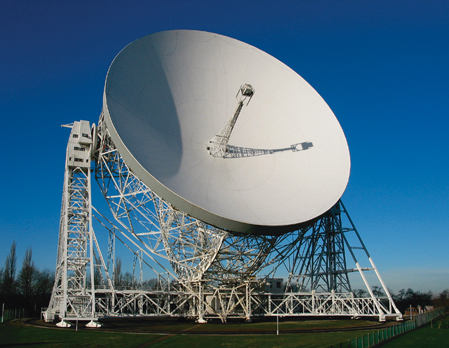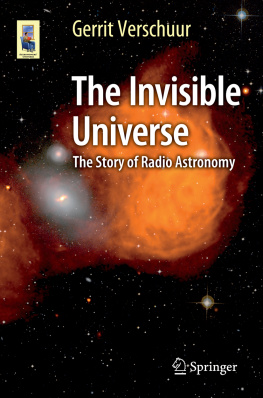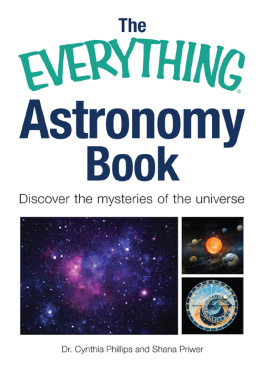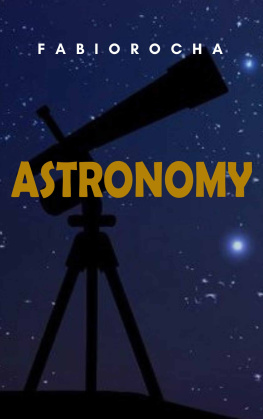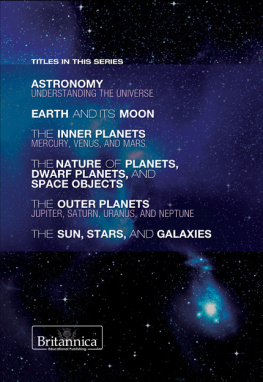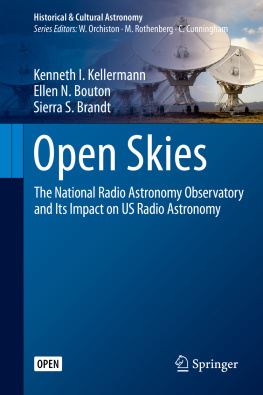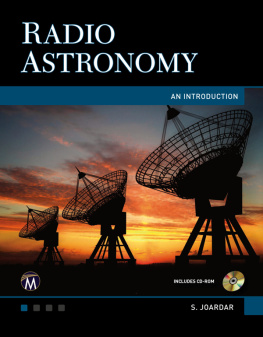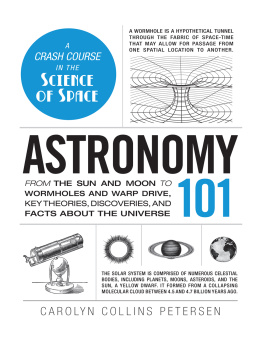As you propel yourself into the invisible universe of radio astronomy, an explanation of some possibly unfamiliar terms will help guide you on your journey.
1.1 A Definition of Radio Astronomy
Radio astronomy involves the study of radio waves from the depths of space. Many objects in the universe emit radio waves through naturally occurring processes. Such objects include stars, galaxies, and nebulae, as well as a wide variety of peculiar, fascinating, and often mysterious objects, such as pulsars and quasars. Radio astronomers study such objects using a variety of radio telescopes, in their simplest incarnation metal dish-shaped reflectors, examples of which are scattered throughout this book. The famous one at Jodrell Bank in England is shown in Fig. , home base for your author for 7 years. Many of the astronomical objects that emit radio waves do not emit much or any light so that radio astronomers study what is essentially an invisible universe not seen by even the worlds largest optical telescopes .
Fig. 1.1
The 250 ft diameter radio telescope at Jodrell Bank in Cheshire, England. This image shows the upgraded version known as the Lovell telescope. At the top of the tall mast in the center of the dish electronic amplifiers attached to a small antenna (or feed, as it is called) are housed in the box at the focal point of the dish. The amplified signal is fed down to a laboratory at ground level or, in the days that I was using the dish, to our lab in the tower at the right . (Photo courtesy of Nuffield Radio Astronomy Laboratories, University of Manchester)
How Radio Waves from Space are Generated
Cosmic radio waves are created in several ways, depending on the physical conditions in the radio-emitting object. Most of the processes involve the movement of electrons; in particular, changes in their velocity during which the electrons lose energy, which can be radiated away as a radio wave. Radio energy is produced either by slow-moving electrons (traveling between tens and hundreds of kilometers per second) within hot clouds of gas that surround very hot stars, for example, or by electrons that have been accelerated to near the speed of light through stellar or larger scale explosions, which energize the particles. The two radio emission processes are known, respectively, as thermal and non-thermal.
Non-thermal emission , sometimes called synchrotron radiation , involves cosmic ray electrons that spiral around magnetic fields and radiate energy and depending on the energy of the particle and the strength of the magnetic field, this process can produce emission at any of the wavelengths across the electromagnetic spectrum (see Appendix A.2). Other sources of radio waves from space involve the radiation from atoms or molecules, to be discussed in Chaps..
What is a Radio Source?
One of the earliest post-World War II discoveries in radio astronomy was that specific regions of the sky seemed to emit more radio energy than their surroundings. Those were given the generic name of radio source. Whenever a larger radio telescope or more sensitive radio receiver was used, more radio sources were discovered. Today millions of radio sources are known.
The list of various types of radio sources includes stars, nebulae, galaxies, quasars, pulsars, the sun, the planets, as well as amazing clouds of molecules between the stars, all of which generate radio waves. The study of the cosmic radio waveswhere they come from, how they are produced, what sorts of astronomical objects are involvedis what radio astronomy is all about.
Single Dish Radio Telescopes
For hundreds of years, ever since Galileo who in 1609 AD first used an optical telescope to study the moon , stars, and planets, astronomers have used glass lenses or a mirror to gather and concentrate light from distant stars and galaxies. The light is then passed through more lenses to bring it to focus on a photographic plate or on a detector to be converted into electrical signals .
In its simplest form a dish-type radio telescope is similar to an optical telescope, but it reflects radio waves off a metal surface instead of a glass mirror. The larger the reflecting surface the greater the amount of energy gathered and the fainter the radio signals that can be sensed.
In January 1961 I arrived at Jodrell Bank to begin my postgraduate work, having just arrived from South Africa. It was a foggy day and I could not see the giant telescope until I was nearly under it. When it loomed out of the fog I was overwhelmed by its awesome size. That image remains deeply etched in my memory. The laboratory of the group I had joined was located 120-ft above ground in what was called the Green Tower, on the right in Fig.. The walls of this lab were made of steel plates and had no insulation. The important elements of the receiving system were in a small, heated enclosure in the lab that barely allowed us to enter to make adjustments when needed. During the infamous winter of 19621963 in England the temperature inside this lab dipped below freezing and remained there for weeks despite having heaters going to keep us warm. After tedious trips up to the focus located 60 feet above the dish (at the time), which required a 4 min one-way ride in a small funicular platform, any attempts to warm my feet by an electric fire upon my return to the lab tended to set my socks smoldering before I even knew that the heat was on. Our midnight observing runs, which required remaining awake from midnight until 10 a.m. tending to paper chart recorders and fixing anything that had failed were a test of endurance. They were also dramatic and fun.
Radio waves from space are reflected off the parabolic surface of the dish to a focus where a small antenna, usually called a feed collects the signals. The feed may be a simple dipole but most often it is a horn antenna designed to soak in as much of the received radio energy as possible. The concentrated radio signals are then converted into electrical voltages in amplifiers connected to the horn. This is known as the front end of the receiver. Those voltages are then sent to the control room where they are amplified a million or more times in the back end of the receiver before being processed in a computer to be displayed in such a way that the radio astronomer can see what the data indicate.
A single-dish radio telescope (see also Appendix A.1) will collect all the radio energy coming from some small area in the heavens at any instant. That area is called the beam and defines the resolution of the telescope, which depends on the observing frequency and the diameter of the dish. The larger the diameter or the higher the frequency, the better the resolution (smaller beam width) . The 250 ft radio telescope shown in Fig. has a beam width of about 12 arc min at a frequency of 1420 MHz.
In order to produce the equivalent of a photograph the single-dish radio telescope has to be systematically scanned across of a section of sky in the same way that a TV image is produced by scanning an electron beam across the TV screen. The intensity of received radio signals is recorded and the data combined to produce a radiograph, the visual image of what a particular direction in the sky looks like to the radio telescope.
